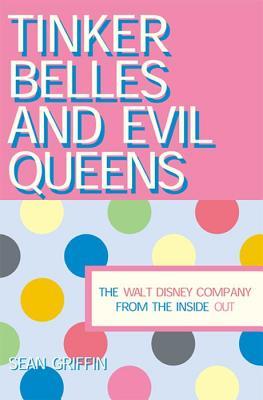“First grubs obscene, then wriggling worms, Then painted butterflies.”—Alexander Pope, Phryne
Maybe I’m bewitched, but I’m not bothered and certainly I’m not bewildered by Sean Griffin’s too divinely unbelievable disquisition on one of everybody’s favorite topics, and I’m not going to waste space by saying what that is, because you just read the title and subtitle and you’ll know what I mean. So don’t be a lazy little troll; just do your homework and I’ll do mine, and we’re going to get along just fine, you and me. I mean, you and I.
Now I am utterly—and I mean entirely, totally, and completely—convinced that Tinker Belles and Evil Queens is a vital work of our time, for so many reasons that I simply can’t enumerate all of them in the stringent space limitation imposed on my freewheeling discourse by the rather bitchy editor of this section of this rather retrograde journal (and believe me, my little chickadees, they could all use some consciousness-raising around here). But clutch my pearls, my extempore effusions are just exhausting my precious space—I’m caught in the glow of my own brilliance, just trapped by the sound of my own dulcet tones! What’s a girl to do?
I simply must pull myself together. But where to start? Begin at the beginning, you silly thing! So, in the first place then, this tome says a lot about the state of the academy de nos jours, being obviously a doctoral dissertation in critical studies at the University of Southern California and afterward—cela va sans dire!—published by N.Y.U., making Griffin bicoastal if not bi-anything else. Of course, as is only too well known, he’s teaching now at Florida Atlantic University. His significant other, Harry Benshoff, is the author of Monsters in the Closet: Homosexuality and the Honor Film (1997), and although Benshoff was cited in the index only twice, I found him in the notes and bibliography more often than that: I just thought that it was so nice ‘n’ cozy that they could be together in print that way. Of course, Benshoffs article, “Heigh-Ho, Height-Ho, Is Disney High or Low? From Silly Cartoons to Postmodern Politics” (Animation Journal, Fall 1992), may have just possibly suggested a teensy weensy something to Griffin about his topic, if you know what I mean, and I just know you do. But this book is state-of-the-art, and to confirm that I looked for the de rigueur citations of Michel Foucault—and there they were. So much for any pesky old academic credibility concerns. You know, it takes me back, really. I used to hang out with Michel, but he had problems. (Did he ever have problems. Quelle horreur!)
But this book also has so much to teach us about style and nuance and theory—it’s a veritable bonanza, a cornucopia, if you’ll permit a frivolous flight of fancy, of instructive examples. Figure-toi: How on earth do we represent the dazzling inflections of our heightened, urgent speech in the boring conventions of ordinary discourse? Griffin has shown the way, and it just reminds me of Dr. Evil in those cute Austin Powers movies. You remember how, with finger gestures, he’d put “quotation marks” about the words he emphasized? Sean Griffin does the very “same” thing, only without the “mimetic” image, by using “quotation marks” around anything that has a “special” meaning. I just got carried away reading those “special” words and phrases: They’re so exciting, and there are so many of them, and I sort of felt like I was actually hearing his very own oral emphases on examples like “queer appreciation,” “opera queen,” “something,” “gay agenda,” “special rights,” “gay Mafia,” “gay community,” “drag queen,” “nonstraight,” “homosexual culture,” “heterosexual agenda,” “capitalist agenda,” “family,” “gay market,” “Disney discourse,” “gay gene,” “homosexuality,” “masculine,” “butch,” “femme,” “ideological state apparatuses,” “other,” “sexuality’,” “the homosexual consumer,” “liberation,” “lesbian,” “gay,” “queer,” “smoking gun,” “gay sensibility,” and “out of the closet”—all these in the introduction alone! Imagine how I thrilled, realizing that such “expression” awaited me for another 290 pages of sheer bliss! This book is better than a Richard Simmons Sweatin’ to the Oldies videotape or anything you care to mention, and in case you don’t “get” the “picture,” I spell this review Fab-U-Lus!!!
Only lack of space and a Glenn Close-type editor could force me to move on so brutally to “nuance.” Griffin excels at “nuance.” And what is a “nuance”? A “nuance” is a “distinction” about “queer theory.” For example: “Gay culture” too often merely denotes “gay white male culture,” and not “lesbian culture,” or “black gay male culture,” or “transgender” or “bisexual culture.” The encompassing term is “queer culture,” not “gay culture,” and theories about that are subsumed under the term “queer theory.”
That last sentence reminds me that my b—- (rhymes with “witch”) editor has left me only a few more words to cover “theory.” As far as I’ve been able to understand, Sean Griffin has shown how capitalism has driven the Disney Company to be friendly to “the gay community.” Along the way, he’s told the story of gay activism at the company, while in his “nuanced” manner, he’s insisted that cooptation by the corporations is a trap that will never lead to “liberation.” Finally, Griffin has rejected, on theoretical grounds, any “post-gay” complacency: Various unpleasant episodes have suggested there’s no basis for feeling the “struggle” is over.
Sanctioned by the academy, Griffin has presented himself as threatened—a neat trick, if you can “pull it off.” But just in today’s newspaper, I noticed a picture of the chortling trio of Bill Clinton, Al Gore, and David Geffen, which suggests that maybe Sean should, like, lighten up. The battle is over, and “we” must have “won”—otherwise, why would a “university press” publish a “work” of such complete “self-absorption?”
Fan-tast-ic!
[Tinker Belles and Evil Queens: The Walt Disney Company from the Inside Out, by Sean Griffin (New York: New York University Press) 292 pp., $55.00]

Leave a Reply